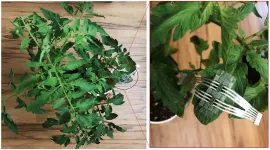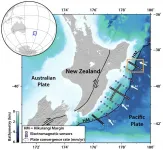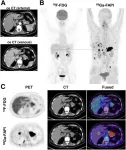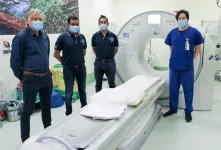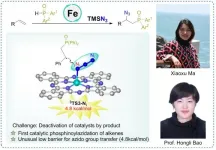(Press-News.org) Researchers from North Carolina State University have developed a patch that plants can "wear" to monitor continuously for plant diseases or other stresses, such as crop damage or extreme heat.
"We've created a wearable sensor that monitors plant stress and disease in a noninvasive way by measuring the volatile organic compounds (VOCs) emitted by plants," says Qingshan Wei, co-corresponding author of a paper on the work. Wei is an assistant professor of chemical and biomolecular engineering at NC State.
Current methods of testing for plant stress or disease involve taking plant tissue samples and conducting an assay in a lab. However, this only gives growers one measurement, and there is a time lag between when growers take a sample and when they get the test results.
Plants emit different combinations of VOCs under different circumstances. By targeting VOCs that are relevant to specific diseases or plant stress, the sensors can alert users to specific problems.
"Our technology monitors VOC emissions from the plant continuously, without harming the plant," Wei says. "The prototype we've demonstrated stores this monitoring data, but future versions will transmit the data wirelessly. What we've developed allows growers to identify problems in the field - they wouldn't have to wait to receive test results from a lab."
The rectangular patches are 30 millimeters long and consist of a flexible material containing graphene-based sensors and flexible silver nanowires. The sensors are coated with various chemical ligands that respond to the presence of specific VOCs, allowing the system to detect and measure VOCs in gases emitted by the plant's leaves.
The researchers tested a prototype of the device on tomato plants. The prototype was set up to monitor for two types of stress: physical damage to the plant and infection by P. infestans, the pathogen that causes late blight disease in tomatoes. The system detected VOC changes associated with the physical damage within one to three hours, depending on how close the damage was to the site of the patch.
Detecting the presence of P. infestans took longer. The technology didn't pick up changes in VOC emissions until three to four days after researchers inoculated the tomato plants.
"This is not markedly faster than the appearance of visual symptoms of late blight disease," Wei says. "However, the monitoring system means growers don't have to rely on detecting minute visual symptoms. Continuous monitoring would allow growers to identify plant diseases as quickly as possible, helping them limit the spread of the disease."
"Our prototypes can already detect 13 different plant VOCs with high accuracy, allowing users to develop a customized sensor array that focuses on the stresses and diseases that a grower thinks are most relevant," says Yong Zhu, co-corresponding author of the paper and Andrew A. Adams Distinguished Professor of Mechanical and Aerospace Engineering at NC State.
"It's also important to note that the materials are fairly low cost," Zhu says. "If the manufacturing was scaled up, we think this technology would be affordable. We're trying to develop a practical solution to a real-world problem, and we know cost is an important consideration."
The researchers are currently working to develop a next-generation patch that can monitor for temperature, humidity and other environmental variables as well as VOCs. And while the prototypes were battery-powered and stored the data on-site, the researchers plan for future versions to be solar powered and capable of wireless data transfer.
INFORMATION:
The paper, "Real-Time Monitoring of Plant Stresses via Chemiresistive Profiling of Leaf Volatiles by a Wearable Sensor," is published in the journal Matter. Co-first authors of the paper are Zheng Li, a former postdoc at NC State who is now an assistant professor at Shenzhen University, and Yuxuan Li, a Ph.D. student at NC State. The paper was co-authored by Jean Ristaino, William Neal Reynolds Distinguished Professor of Plant Pathology at NC State; Oindrila Hossain, Rajesh Paul and Shuang Wu, who are Ph.D. students at NC State; and Shanshan Yao, a former postdoc at NC State who is now an assistant professor at Stony Brook University.
The work was done with support from the NC State Chancellor's Faculty Excellence Program; the Kenan Institute for Engineering Technology & Science; NC State's Game-Changing Research Incentive Program for the Plant Science Initiative (GRIP4PSI); the NC State Center for Human Health and the Environment Pilot Project Award from the U.S. Department of Agriculture, number 2019-67030-29311; USDA APHIS Farm Bill grant number 3.0096; and the National Science Foundation, under grant 1728370.
The Hikurangi Margin, located off the east coast of the North Island of New Zealand, is where the Pacific tectonic plate dives underneath the Australian tectonic plate, in what scientists call a subduction zone. This interface of tectonic plates is partly responsible for the more than 15,000 earthquakes the region experiences each year. Most are too small to be noticed, but between 150 and 200 are large enough to be felt. Geological evidence suggests that large earthquakes happened in the southern part of the margin before human record-keeping began.
Geophysicists, geologists, and geochemists from throughout the world have been working together to understand why this plate boundary behaves as it does, producing both imperceptible silent earthquakes, but also potentially major ...
Reston, VA--For patients with pancreatic ductal adenocarcinomas (PDAC), molecular imaging can improve staging and clinical management of the disease, according to research published in the June issue of The Journal of Nuclear Medicine. In a retrospective study of PDAC patients, the addition of PET/CT imaging with 68Ga-FAPI led to restaging of disease in more than half of the patients, most notably in those with local recurrence.
PDAC is a highly lethal cancer, with a five-year survival rate of less than 10 percent. Optimal imaging of PDAC is crucial for accurate initial TNM (tumor, node, metastases) staging and selection ...
Dancing with music can halt most debilitating symptoms of Parkinson's disease
First-of-its-kind York U study shows participating in weekly dance training improves daily living and motor function for those with mild-to-moderate Parkinson's
TORONTO, July 7, 2021 - A new study published in Brain Sciences today, shows patients with mild-to-moderate Parkinson's disease (PD) can slow the progress of the disease by participating in dance training with music for one-and-a-quarter hours per week. Over the course of three years, this activity was found to reduce daily motor issues such as those related to balance and speech, ...
When a head of state or government official travels to another country to meet with his/her counterpart, the high-level visit often entails a range of public diplomacy activities, which aim to increase public support in the host country. These activities often include events such as hosting a joint press conference, attending a reception or dinner, visiting a historic site, or attending a social or sports event. A new study finds that public diplomacy accompanying a high-level visit by a national leader increases public approval in the host country. The findings are published in the American Political ...
The Arctic is warming at approximately twice the global rate. A new study led by researchers from McGill University finds that cold-adapted Arctic species, like the thick-billed murre, are especially vulnerable to heat stress caused by climate change.
"We discovered that murres have the lowest cooling efficiency ever reported in birds, which means they have an extremely poor ability to dissipate or lose heat," says lead author Emily Choy, a Postdoctoral Fellow in the Natural Resource Sciences Department at McGill University.
Following reports of the seabirds dying in their nests on sunny days, the researchers trekked the cliffs ...
Data from nine cities in Mexico confirms that identifying dengue fever “hot spots” can provide a predictive map for future outbreaks of Zika and chikungunya. All three of these viral diseases are spread by the Aedes aegypti mosquito. Lancet Planetary Health published the research, led by Gonzalo Vazquez-Prokopec, associate professor in Emory University’s Department of Environmental Sciences. The study provides a risk-stratification method to more effectively guide the control of diseases spread by Aedes aegypti. “Our results can help public health officials to do targeted, proactive interventions ...
Prostate cancer is the most diagnosed cancer and a leading cause of death by cancer in Australian men.
Early detection is key to successful treatment but men often dodge the doctor, avoiding diagnosis tests until it's too late.
Now an artificial intelligence (AI) program developed at RMIT University could catch the disease earlier, allowing for incidental detection through routine computed tomography (CT) scans.
The tech, developed in collaboration with clinicians at St Vincent's Hospital Melbourne, works by analysing CT scans for tell-tale signs of prostate ...
Phosphinoylazidation of alkenes is a direct method to build nitrogen- and phosphorus-containing compounds from feedstock chemicals. Notwithstanding the advances in other phosphinyl radical related difunctionalization of alkenes, catalytic phosphinoylazidation of alkenes has not yet been reported. Thus, efficient access to organic nitrogen and phosphorus compounds, and making the azido group transfer more feasible to further render this step more competitive remain challenging.
Recently, a research team led by Prof. Hongli Bao from Fujian Institute of Research on the Structure of Matter, Chinese Academy of Sciences (CAS) reported the first iron-catalyzed phosphinoylazidation of alkenes under ...
The growing rate of ice melt in the Arctic due to rising global temperatures has opened up the Northwest Passage (NWP) to more ship traffic, increasing the potential risk of an oil spill and other environmental disasters. A new study published in the journal Risk Analysis suggests that an oil spill in the Canadian Arctic could be devastating--especially for vulnerable indigenous communities.
"Infrastructure along the NWP in Canada's Arctic is almost non-existent. This presents major challenges to any response efforts in the case of a natural disaster," says Mawuli Afenyo, lead author, University of Manitoba researcher, and expert on the risks of Arctic shipping.
Afenyo and his colleagues have developed a new ...
(Boston)--High-risk neuroblastoma is an aggressive childhood cancer with poor treatment outcomes. Despite intensive chemotherapy and radiotherapy, less than 50 percent of these children survive for five years. While the genetics of human neuroblastoma have been extensively studied, actionable therapeutics are limited.
Now researchers in the Feng lab at Boston University School of Medicine (BUSM), in collaboration with scientists in the Simon lab at the Perelman School of Medicine at the University of Pennsylvania (Penn), have not only discovered why this cancer is so aggressive but also reveal a promising therapeutic approach to treat these patients. These findings appear online in the journal Cancer Research, a journal ...
